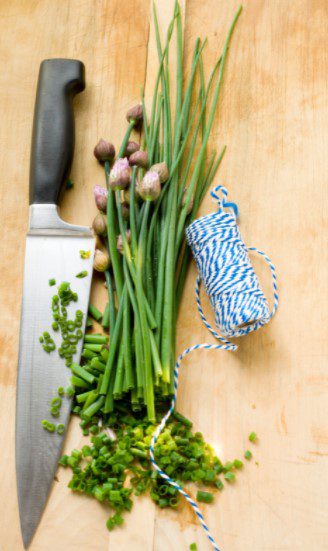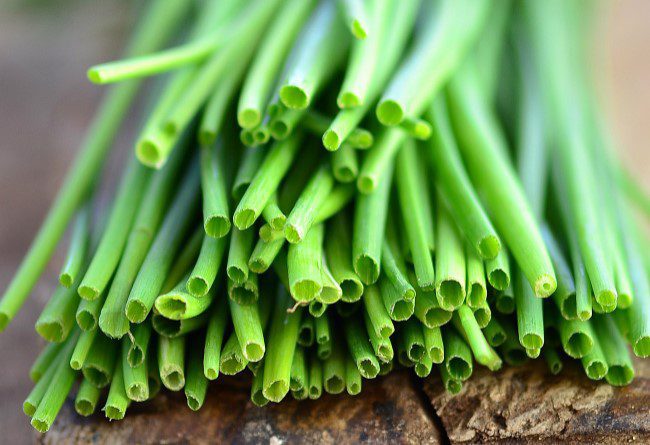Chives
The chive (allium schoenprasum) is the smallest of the alliums, the family that includes onions, scallions, leeks, garlic, and shallots. With a mild onion flavor (lighter than scallions or garlic chives), the plant is prized for its slender, hollow stalks, not its bulbs.
It is harvested by snipping those stalks, never uprooting the bulb as you would an onion. And the stalks grow back once cut, so it makes a steady and reliable occupant of a pot on the kitchen window sill or a spot in the garden just outside the kitchen door, where, if you don’t snip it for a while, it will reward you with its pale purple and very edible flowers.
It can be dug into the garden now, where it will reward you with a summer of flavor and will often survive the winter (even this winter) if somewhat protected. Chives can also be snipped and frozen, and added directly to recipes. There is, therefore, no excuse to buy dried chives, tasteless as sawdust.
How to Grow Chives
Chives are ornamental plants that can be used in rock gardens and borders.
They are commonly grown as a garden herb for their table use, but they can also be used as a decorative plant for rock gardens.
They can also be grown in pots and placed on a windowsill all year to ensure a continuous harvest.
Chives love the sun, good drainage, and adequate moisture. Before planting, it is a good idea for you to add 4 to 6 inches worth of compost.
Chives are clump-forming and can easily become overcrowded. Therefore, it is important to divide the clumps frequently to maintain vigorous growth.
They may be evergreen in warm climates; they will fall to the ground each autumn and return as perennials in spring.
Chives are shallow-rooted plants. Be careful about what you plant around them.
Gardeners who grow chives for edible herbs might cut back the flowers to stop them from becoming seedlings. The blooms are edible, and you can enjoy them.
However, the plants will self-seed quite freely, leaving you with many volunteers. However, this is not an invasive species.
Although chives are not susceptible to serious diseases or pests, root-rot can cause clumps that grow in poorly drained soil.
HOW TO BUY
Look for sprightly, firm chives that are uniformly green with no brown or spots that don’t appear wilted.
HOW TO STORE
Place chives in a plastic bag and refrigerate, unwashed, for up to one week.
HOW TO PREPARE
Snip and sprinkle. Chives can garnish just about anything, from soups (especially vichyssoise) and sauces to omelets and baked potatoes. Add them to marinades and vinaigrettes. Stir them into compound butter for corn on the cob.
Dress up steamed sugar snap peas, boiled green beans, or sauteed radishes. Add them to your favorite biscuit batter.

Use them to make an herb paste with some tarragon and sour cream and spread it on a salmon fillet before it hits the grill or the oven. Blend them with cream and butter for a light pasta sauce.
I’m told some cooks with agile hands and lots of time use uncut chives as if they were ribbons, wrapping up a tea sandwich or a bundle of julienned vegetables, and even tying the chive into a bow. I don’t happen to know any of those people.
Crostini With Chive-Scented Ricotta
(Makes 2 cups, enough for 20 crostini)
Though the chive and ricotta blend works wonderfully atop bread, it can also sauce pasta or enrich scrambled eggs. From “Local Flavors” by Deborah Madison (Broadway, 2002)
2 cups ricotta cheese
2 tablespoons olive oil
Sea salt and fresh ground pepper to personal taste
6 tablespoons very finely snipped chives
20 slices baguette, ciabatta or a nutty, dense, whole-wheat bread, toasted
Chive blossoms, cut at the base (optional)
Mix the ricotta, oil, salt, and pepper in a medium bowl to taste and chives.
Spread the cheese mixture evenly over the toast. If desired, sprinkle each slice with additional pepper and a few chive blossoms. Serve immediately.
Per serving: 123 calories, 5 gm protein, 14 gm carbohydrates, 5 gm fat, 12 mg cholesterol, 2 gm saturated fat, 187 mg sodium, 1 gm dietary fiber
Crisp Potato Cakes With Smoked Salmon and Chives
(8 servings)
Though chives are often garnished, their slightly garlicky flavor is incorporated throughout this hearty brunch entree. Serve with a mini salad of mixed greens from a recipe by the cable TV’s Food Network’s Tyler Florence.
6 large russet potatoes, baked and cooled
2 tablespoons olive oil, plus additional for sauteing
2 tablespoons sour cream
2 bunches of chives, minced
13 eggs
Salt plus fresh ground black or white pepper
1/4 cup milk
4 tablespoons unsalted butter
About 4 ounces diced smoked salmon
Once the potatoes have cooled, remove and discard the skins. Using a box grater, roughly grate the potatoes into a large bowl. Add the oil, sour cream, and half of the minced chives and mix well.
In another bowl, lightly beat 1 egg. Add the egg to the potato mixture and mix well. Sprinkle with salt and pepper to your own liking.
Arrange a plate lined with a paper towel. With your hands, make 8 big potato cakes. (You can make the potato cakes before, wrap them in plastic wrap and refrigerate until ready to be used.) In a standard pan over medium-high heat, heat about 2 tablespoons of oil.
Decrease the heat to medium and stir the potato cakes, 1 or 2 at a time, until crisp, about 3 minutes per side, adding additional oil if required. Remove the cakes to the plate; put them aside in a warm place.
In a Big bowl, lightly whisk the remaining 12 eggs. Add the milk, salt, and pepper to your own liking and whisk to integrate.
In a large non-stick pan over medium heat, melt the butter. Cook, slowly stirring the eggs almost constantly, until the eggs form clots and are cooked to the degree of doneness, 10 to 15 minutes.
When the eggs are cooked, gently fold in the smoked salmon, half of the remaining minced chives, and salt and pepper to taste.
To serve, place a warm potato cake in the middle of each plate and divide the eggs evenly among the cakes. Decorate with the remaining chives and serve at once.
Per serving: 353 calories, 10 gm protein, 35 gm carbohydrates, 20 gm fat, 136 mg cholesterol, 8 gm saturated fat, 242 mg sodium, 3 gm dietary fiber


























